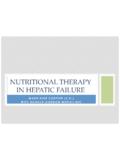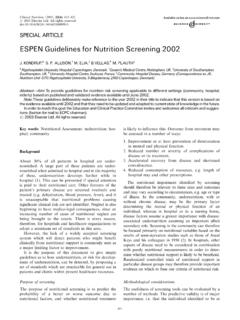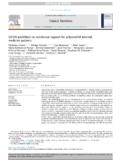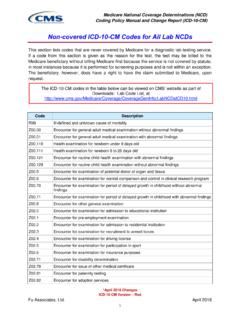Transcription of The Nutritional Relationships of the Thyroid - Trace …
1 The Nutritional Relationships of the ThyroidDavid L. Watts, , , , et al, estimate that 40% of the American population suffer from Thyroid dysfunction and that hypothyroidism is the most common complaint seen by doctors in this Several factors contribute to clinical Thyroid dysfunction such as diseases affecting the gland itself or a disturbance in the hypothalamic pituitary Thyroid axis. Subclinical Thyroid dysfunction particularly, hypothyroidism, is more common than clinical pathology of the Thyroid gland. Subclinical hypothyroidism can produce or contribute to an array of metabolic dysfunctions and symptoms that may respond readily to a conservative Nutritional Associated with Hypothyroidism Severe clinical Thyroid insufficiency is associated with many conditions including myxedema, cretinism in children, goiter, arteriosclerosis, and Subclinical hypothyroidism is more common and is not always easily detectable through normal testing procedures.
2 Subclinical hypothyroidism could be described as a syndrome rather than a disease and is characterized by fatigue, depression, cold sensitivity, and changes in the skin and hair texture. The development of fatigue is usually insidious, resulting in the requirement of extra sleep. Depression may develop often and become more prolonged with each episode. Cold sensitivity first develops in the extremities. Cold hands and feet may become present even in the summer. The skin becomes dryer, and the hair may become coarse or thin, with accompanying hair loss. Nutritional Deficiency and HypothyroidismA number of Nutritional deficiencies are known to develop in subclinical hypothyroidism.
3 The most recognized is iron deficiency. Elements, Inc., Box 514, Addison, Texas resulting anemia can be in the form of normochromic, normocytic, hypochromic, microcytic, macrocytic, or The incidence of anemia is estimated to affect up to 60% of those patients with hypothyroidism and is not related to severity or duration of Thyroid insufficiency. Other related deficiencies are protein deficiency, perhaps due to accompanying hypochlorhydria; deficiency in vitamins A, C, B6,B5, B1; and mineral deficiency: phosphorus (P), manganese (Mn), magnesium (Mg), potassium (K), sodium (Na), and chromium (Cr).
4 Keyvani, et al, found that low vitamin A levels are associated with an increase in the prevalence of goiter in subjects under 18. After the age of 18, females were more affected by goiter than males, who were found to have higher vitamin A increase in tissue estrogen sensitivity in the presence of vitamin A deficiency may explain the increased prevalence in Zinc deficiency has also been found in children with grade 1 goiters in conjunction with a deficiency of vitamin InhibitorsFirst we should review some of the naturally occurring Thyroid inhibitors. These factors are not usually considered in the course of Thyroid therapy; this may explain the often slow response of patients given synthetic Thyroid preparations.
5 Frequently patients prescribed synthetic Thyroid or thyroxine do not respond to therapy for six months. Consideration of these known Thyroid inhibitors may produce quicker response to medications, but they may also respond to a more conservative Nutritional approach. Figure 1 shows the many Nutritional factors that are known to antagonize Thyroid activity or Laetrile Amygdalin Aromatic Isothiocyanates It has long been known that amygdylan 165 Journal of Orthomolecular Medicine Vol. 4, No. 3, 1989 affects Thyroid function.
6 Evidence that thiocyanates exhibited an anti- Thyroid effect was noted with its use as an Thyocyanates are still being used as an anti-hypertensive. Sodium ni-troprusside (trade Name Niprid (R) Roche) was characterized as being "the drug of choice" in the management of hypertensive crises by the AMA Department of Drugs in 1977. It is interesting to note that cruciferae plants that are known to inhibit Thyroid activity are also high in amygdylin. This plant group includes cabbage, broccoli, brussels sprouts, cauliflower,8 as well as almonds, cassava, yam, maize, apricots, prunes, and bamboo B12, Cobalt (Co)Cobalt and vitamin B12 are closely related.
7 Therefore, either can have adverse effects upon the Thyroid and contribute to 's effect on the Thyroid was seen in patients being treated with cobalt for D, Calcium (Ca)The inhibitory action of calcium on the Thyroid has been suspected since the last century, but more recent studies have confirmed its 14 It is known that calcium decreases Thyroid activity and that calcium absorption is increased in Thyroid Vitamin D would also be considered to contribute to lowered Thyroid function due to its close, synergistic relationship to calcium. Studies have shown that serum Vitamin D3 metabolites are increased in hypothyroid patients16 and reduced in hyperthyroid Acid (PABA)PABA has been used in the treatment of thyrotoxicosis.
8 PABA compounds used in the treatment of tuberculosis have been known to produce (Li)Hypothyroidism is a well-known side effect associated with lithium therapy. Lithium apparently affects calcium as well. Studies have shown that serum calcium increases and serum phosphorus becomes depressed in patients treated with lithium,19 which is probably due to lithium induced hyperparathyroidism reported byShen, et (Mo), Bromine (Br)Experiments have shown that molybdenum suppresses Thyroid activity in animals. Bromine, another anion, inhibits the active transport of is required for normal Thyroid function, but with excessive intake it becomes a Thyroid suppressant.
9 The occurrence of endemic goiter in China was found to be due to the high concentration of iodine in drinking has long been used therapeutically in the treatment of (Cu)Copper can be considered a Thyroid antagonistic agent due to its close relationship with estrogen (to be discussed later) as well as its antagonistic relationship to iron and zinc. Cecil24has described the relationship of iron deficiency and hypothyroidism. More recent studies have shown that iron deficiency can impair Thyroid function and that iron status can reflect Thyroid It has also been found that during iron deficiency, the conversion of L-phenylalanine to L-tyro-sine is reduced by as much as 50%.
10 26 Thyroid Endocrine InhibitorsOveractivity of other endocrine glands can contribute to hypothyroidism. An increase in circulating hormones, even while in normal serological limits, can suppress or decrease the response of Thyroid therapy. The endocrine glands have opposing activity similar to vitamins and minerals. Overactivity can suppress an opposing gland, and underactivity can allow increased is closely associated with the mineral copper. In the serum, they tend to fluctuate simultaneously. It is highly probable that estrogen as well as copper inhibits Thyroid activity.









